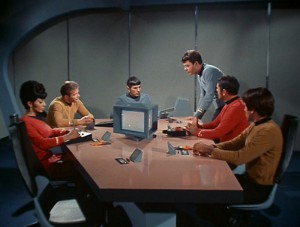Writing Conference Scenes
 When you’re writing a scene where characters discuss the plan — no matter if it’s how to pull off the heist or how to save the ship, or where the killer might strike next — there’s always a danger of going into character overload. By that I mean you create a scene with so many characters that the reader (and maybe you , the writer) can’t keep everyone straight.
When you’re writing a scene where characters discuss the plan — no matter if it’s how to pull off the heist or how to save the ship, or where the killer might strike next — there’s always a danger of going into character overload. By that I mean you create a scene with so many characters that the reader (and maybe you , the writer) can’t keep everyone straight.
If you’re working with established characters in a TV show, it’s different. The original Star Trek had briefing room conferences all the time, but because these moments were usually with the series regulars, knowing who they were wasn’t much of an issue. If you were to write a briefing room scene on a whole new starship, though, think about all the shorthand you couldn’t do. Who’s that guy, and what’s his specialty? How do I introduce this woman’s important tactical information without having to go into pages of detail about who she is? These kinds of writing challenges used to drive me crazy.
I just read a virtual blizzard of Richard Stark Parker novels, and while they’re pretty far away from the “save the ship” briefing room scenes I grew up watching, they serve as models in many ways for the crafting of a good conference.
As always, I don’t think there are absolutes, so I think of these points I’m about to lay down as guidelines, not rules.
1. Don’t start your story with the conference room scene. There are just too many characters to introduce all at once.
2. Begin with the events in motion. If the important details happened in the meeting earlier, then do a flashback. Or start the story BEFORE the conference scene is necessary.
3. Introduce at least one principal character BEFORE the conference. That way we know someone before we’re tossed into a room full of people. If that character is on her way to the meeting, she can be thinking about one person she dreads being there or someone she’s pleased who WILL be. But she shouldn’t be thinking about ALL the people who are going to be there, because then we’re back to character overload again.
4. Have that character meet with one of the other characters outside the room of the conference. That way the reader gets some sense of their relationship and what our principal character thinks of them. AND we now know two people who will be in the room talking.
5. Once the conference starts, tag the new characters with a distinctive concern. Scotty’s worried about the drain on the engines. McRuff is worried about the criminal’s next move. Grofield inserts an occasional wisecrack. Sundance just wants the money.
You can’t weigh things down with a whole lot of description or give detailed backgrounds. If this is the first time the principal meets many of the characters, she’s mostly going to be getting first impressions and you can get more in depth about what they look like later (plus paragraphs of detail about each character as they’re introduced really bogs down pacing).
The purpose of these conference scenes is to show how the characters work together, to explore their relationships, and to inform the reader about what’s going on. There may be all kinds of subtext — perhaps McRuff doesn’t like Scotty for some past transgression, and a little hostility comes out when they talk. This probably isn’t the place to explain the history, which can be dolled out later. Mystery is good. It leaves a reader wanting to know why those characters interact like that and leaves you with material to explore.
Speaking of exploring material, I’m off to write. Hope this helps someone out there!
7 Comments